April 3-17, 2003
Tijuana, Baja California, Mexico
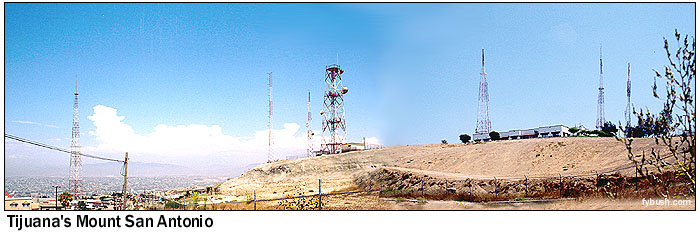
In the last two installments of Site of the Week, we've been
recapping an August 2001 visit to the many interesting sites
of San Diego, California. But San Diego is just one half of a
fascinating two-nation market; every day, millions of San Diegans
tune in to signals that emanate from across the border in Mexico,
often without even realizing it. (Listen to "Xtra Sports
Radio 690" or "91X" or "Z90," and the
only clue that it's a Mexican station is the softly-spoken legal
ID in Spanish that's buried around the top of the hour - or,
for the especially astute listener, the Mexican national anthem
at midnight and the Sunday-night simulcast of the "Hora
Nacional" broadcast from Mexico City.)
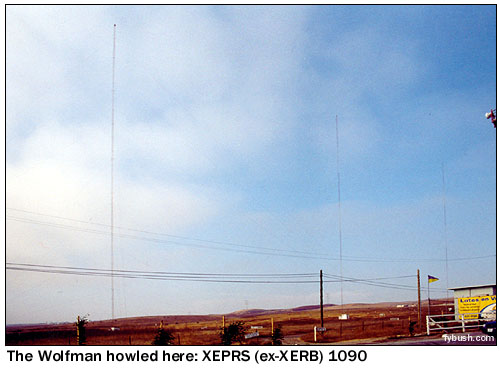 This sort of cross-border
broadcasting has a long and colorful history, stretching back
to Dr. Brinkley's goat-gland broadcasts over station XER from
Ciudad Acuna, across the border from south Texas, in the thirties.
In the Tijuana area, the first "border blaster" was
XEBC, broadcasting from the Agua Calienta Spa just south of the
border in the early thirties. This sort of cross-border
broadcasting has a long and colorful history, stretching back
to Dr. Brinkley's goat-gland broadcasts over station XER from
Ciudad Acuna, across the border from south Texas, in the thirties.
In the Tijuana area, the first "border blaster" was
XEBC, broadcasting from the Agua Calienta Spa just south of the
border in the early thirties.
In 1937, XEBC (and another lower-powered border station, XEMO)
were joined by XERB at Rosarito Beach, with a 50,000 watt signal
on 1090 that sailed nicely up the Pacific coast to take in the
entire LA basin, day and night - the perfect home a few decades
later for Wolfman Jack's howling late-night broadcasts, taped
in a studio in Hollywood and ferried across the border to the
1090 transmitter site on the Mexican coast, where the "Mighty
X" delivered them to a waiting audience all over southern
California.
Down the dial at 690, the ever-innovating Gordon McLendon
took over a station called XEAK in 1961, flipping it to the first
all-news format ever heard on English-language radio (the format
was already well established in Havana, of all places, albeit
in Spanish!) as "XETRA," "Extra Radio 690."
With a team of announcers reading wire-service stories in a half-hour
cycle (gradually expanded from first 7 minutes, then 15 minutes,
once McLendon realized how long the LA commute really was), XETRA
was a preview of the all-news format that would become common
on the U.S. side of the border a few years later - and to its
listeners, it was a U.S. based station, "in
the air all over southern California at 690 on the dial"
from 1961 until 1966, when a dispute with his Mexican partners
led McLendon to lose control of the station.
XERB eventually became XEPRS, "Radio Express," still
serving a cross-border audience but now in Spanish (it just flipped
back to English as all-sports "Mighty 1090" in February
2003); XETRA went through a variety of formats, including oldies
with Wolfman Jack back at the mike, before landing on sports
as well a few years back - but the cross-border fun continues
on FM, where XETRA-FM (91.1), aka "91X," has been rocking
San Diego for a generation, joined by newer stations like "Z90"
(XHITZ 90.3), "Magic 92.5" (XHRM 92.5) and "Bob"
(XHCR 99.3).
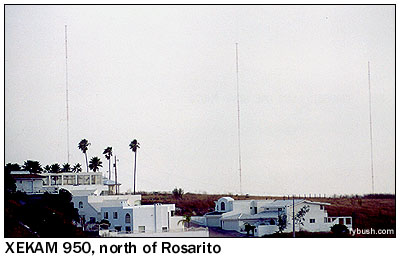 Tijuana even provides
San Diego with its Fox network service, thanks to XETV (Channel
6), which was once the ABC affiliate for both sides of the border! Tijuana even provides
San Diego with its Fox network service, thanks to XETV (Channel
6), which was once the ABC affiliate for both sides of the border!
At the top of the page, we see the home to most of the big
Tijuana FM and TV stations: Mount San Antonio, the rise of land
south of downtown Tijuana that's easily visible from the border
crossing (though not so easy to actually get to - the roads are
steep and not well paved!)
In the photomontage shown here, my back was towards the tall
self-supporting tower of XHAS (Channel 33), the Telemundo affiliate
that serves both San Diego and Tijuana. At the right side of
the picture is the studio and tower of XEWT (Channel 12), Tijuana's
premiere Spanish-language station, on the air now for well over
40 years. XETV is up here as well (though its studios are in
San Diego's Kearney Mesa area), and I believe most of the big
cross-border FMs are here, too. The self-supporting tower at
the left of the frame is (I think!) the tower for TV Azteca's
Tijuana relay stations, XHTIT (Channel 21) and XHJK (Channel
27); XEWT's tower is also home to XHUAA (Channel 57), a relay
of Mexico City's XEW-TV (Channel 2). Only XETV, XEWT and XHAS
enjoy any significant cable carriage north of the border, though
the 21, 27 and 57 signals are visible off-air in much of San
Diego.
That's the three-tower XEPRS site shown above at left, along
toll highway 2 south of Tijuana and north of Rosarito. It's very
close to the towers of XEKAM (950), a Spanish-language talk station
that targets listeners on both sides of the border, as well as
to the former site of XEPRS. I didn't see the current XEPRS on
this trip; it's now south of Rosarito with a directional 77,500-watt
signal aimed north at San Diego and Los Angeles.
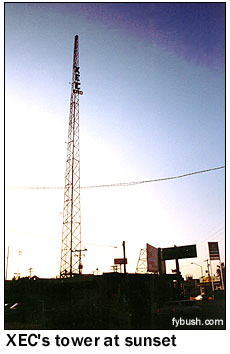 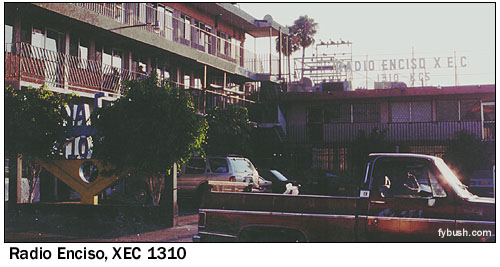
Tijuana has a vibrant radio scene of its own, too, with many
smaller stations devoting themselves completely to the Mexican
side of the market. At left and above is the site of XEC (1310),
"Radio Enciso" (named for the family that owns it;
calls are given during a top-hour legal ID that generally also
includes the station's power but usually not used during the
rest of the broadcast hour), one of the oldest of the local stations,
broadcasting from that nice little tower right in the heart of
downtown Tijuana (and the studios next door). Too bad the sun
was in just the wrong direction that afternoon; I guess I'll
have to return some morning someday to get some better pictures!
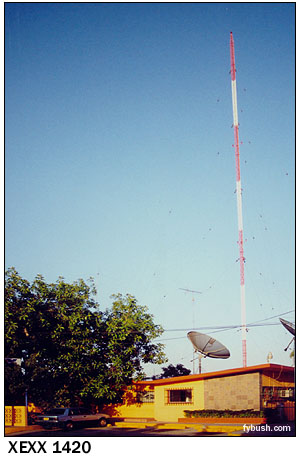 Like XEC, most of
the stations in town are nondirectional, often broadcasting from
unimpressive towers in crowded residential areas. At left is
XEXX (1420), one of the better local signals; it was doing talk
as "Doble X" back in 2001 but has more recently hooked
up with one of the Spanish religious networks from north of the
border. XEXX was also at one time the Spanish flagship for L.A.
Dodgers baseball! Like XEC, most of
the stations in town are nondirectional, often broadcasting from
unimpressive towers in crowded residential areas. At left is
XEXX (1420), one of the better local signals; it was doing talk
as "Doble X" back in 2001 but has more recently hooked
up with one of the Spanish religious networks from north of the
border. XEXX was also at one time the Spanish flagship for L.A.
Dodgers baseball!
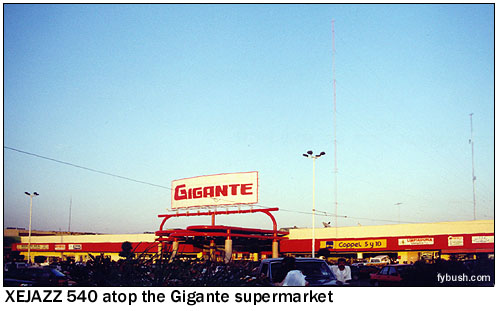
Keep heading east towards the Otay Mesa border crossing, as
we did at the end of this little day trip into Mexico, and you'll
come to a Gigante supermarket, one of the biggest chains in Mexico
- but this one is a little unusual. Up there on the roof is a
fairly tall, and fairly new, tower! It's home to the station
that was called XEJAZZ when we visited, part of Saul Levine's
little network that once included the 540 in Costa Mesa CA (which
actually transmitted from way out in the desert beyond San Bernardino,
and has since been silenced to improve the Tijuana signal), the
1260 in Beverly Hills and classical KMZT (105.1) Los Angeles.
Today, this 540 is XESURF, doing standards as "K-Surf,"
and the signal gets out surprisingly well from that stick.
Up on two nearby hills are two more non-directional towers:
one is home to XEMO (860), still playing that regional Mexican
music after all these years; the other to XEUT (1630), the first
X-band station in Mexico, broadcasting from the local university
on a limited schedule, with some very diverse music indeed.
A few other single-tower sites scattered around town are home
to XEMMM (800), now the ESPN Radio affiliate for San Diego; XEAZ
(1270), doing talk from a site practically across the street
from the U.S. border fence on the west side of town; XERCN (1470),
now the Radio Unica affiliate and XEBG (1550), another talker.
And that's what we saw in a few hours in Mexico - just enough
to whet the appetite for a return trip, I'd say!
(We'll be back in two weeks with our next installment; in
the meantime, it's off to southern California and Las Vegas for
this year's NAB convention!)
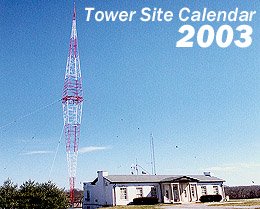 Want to see more neat sticks all year
round? Nashville's WSM (at left) is one of the more than
a dozen Tower Site images featured in the 2003 Tower Site Calendar,
still available from Tower Site of the Week and fybush.com. Want to see more neat sticks all year
round? Nashville's WSM (at left) is one of the more than
a dozen Tower Site images featured in the 2003 Tower Site Calendar,
still available from Tower Site of the Week and fybush.com.
If you liked last year's edition, you'll love this one: higher-quality
images (in addition to WSM, this year's edition includes Providence's
WHJJ; Mount Mansfield, Vermont; Buffalo's WBEN; KOMA in Oklahoma
City; WTIC, Hartford; Brookmans Park, England; WPAT, Paterson;
Four Times Square, New York; WIBC in Indianapolis; WWVA in Wheeling,
W.V.; WGN Chicago and more), more dates in radio history, a convenient
hole for hanging - and we'll even make sure all the dates fall
on the right days!
This year's edition is still available in limited quantities!
And this year, you can order with your Visa, MasterCard,
Discover or American Express by using the handy link below!
Better yet, here's an incentive to make your 2003 NERW/Site
of the Week subscription pledge a little early: support NERW/fybush.com
at the $60 level or higher, and you'll get this lovely calendar
for free! How can you go wrong? (Click here
to visit our Support page, where you can make your NERW contribution
with a major credit card...)
You can also order by mail; just send a check for $16
per calendar (NYS residents add 8% sales tax), shipping included,
to Scott Fybush, 92 Bonnie Brae Ave., Rochester
NY 14618.
Thanks for your support!
|